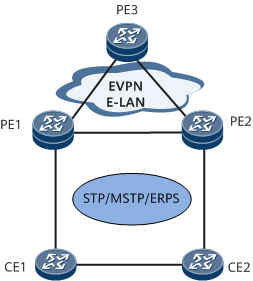Support for Ring Network Access by EVPN
On the network shown in Figure 1, CE1, CE2, PE1, and PE2 form a ring network, and CE1 and CE2 are dual-homed to PE1 and PE2. To prevent routing loops and eliminate network resource waste caused by redundant traffic, deploy a loop prevention protocol. Currently, MSTP, ERPS, or STP can be deployed to prevent loops.
MSTP Deployed for Ring Network Access Based on the BD EVPN Instance
On the network shown in Figure 1, MSTP is deployed on the ring network formed by CE1, CE2, PE1, and PE2. PE1 and PE2 are configured with the same ring ID.
The PEs establish EVPN BGP peer relationships with each other and then exchange Ethernet segment routes.
After receiving an STP TC/TCN BPDU, the AC interface on PE1 (PE2) notifies its sub-interfaces bound to BDs of the topology change, and transparently transmits the BPDU to PE2 (PE1).
- The BD EVPN instance on PE1 detects the topology change, triggers the deletion of local MAC entries, and sends an Ethernet A-D per-EVI route carrying the MAC-Flush and Ring ID extended community attributes to instruct PE2 to quickly delete MAC entries.
- After receiving the Ethernet A-D per-EVI route carrying the MAC-Flush and Ring ID extended community attribute from PE1, PE2 compares the Ring ID extended community attribute value of the route with the locally configured ring ID. If they are the same, PE1 and PE2 are connected to the same ring network. In this case, PE2 nullifies the MAC routes learned from PE1 and deletes the corresponding local MAC entries.
After detecting the network topology change through the Ethernet A-D per-EVI route sent by PE1, PE2 adds the MAC-Flush and Ring ID extended community attributes to its local Ethernet A-D per-EVI route and floods the route on the network. In this way, other PEs on the network can nullify the MAC routes learned from PE2 to achieve fast convergence.
- After other PEs receive the Ethernet A-D per-EVI routes, they nullify MAC routes learned from PE1 and PE2.
ERPS/STP Deployed on a Ring Network Based on the BD EVPN Instance
On the network shown in Figure 1, ERPS/STP is deployed on the ring network formed by CE1, CE2, PE1, and PE2.
The PEs establish EVPN BGP peer relationships with each other and then exchange Ethernet segment routes.
After the AC interfaces on PE1 and PE2 receive TC/TCN BPDUs, the corresponding BD EVPN instances detect the topology change, trigger the deletion of local MAC entries, and send Ethernet A-D per-EVI routes carrying the MAC-Flush and Ring ID extended community attributes to other PEs on the network for fast convergence.
After other PEs receive the Ethernet A-D per-EVI routes, they nullify the MAC routes learned from PE1 and PE2.
